Sejla Kameric (Sarajevo) Go to Sejla Kameric's Homepage
1. Bosnian Girl
2. Basics
3. HomeSICK
4. Imagine
5. Original Work of Art in Residence for 1 Month "Sejla-san
/ ZC ² / Sejla Dream"
Appendix: 1.EU/Others 2. Fortune Teller
Buy Sejla's Artwork and Help Another Expo!
1. Bosnian Girl
Graffiti gNo teeth...? A mustache...? Smel like shit...? Bosnian Girl!h written by the unknown Dutch soldier on the wall of the army barracks in Potocari, Srebrenica f94/f95. The Royal Netherlands Army Troops, as a part of the UN Peace Keeping Forces UNPROFOR in Bosnia and Herzegovina 1992-95 were responsible for protection of Srebrenica safe area.
There is no other area as Former Yugoslavia which faced the difficulty of the structure of the Nation-State in the 1990s. Bosnian War was such a complicated war, and there are many arguments between intellectuals whether or not the Bosnian War is a civil war. To think about Yugoslavia gives us a clue to think about the future of post Nation-State world.
Unfortunately, Sejla Kameric lost her father in Bosnian war. Lots of artists who faced the difficulty of war became nationalistic, or even quit the art making, such as Adorno suggests. However, while lots of male artists faces the difficulty of art making, Kameric sublimate the traumatic experience to the beautiful art form.
In the spring of 1993, the UN established six gsafe areash for Muslims, towns where UNPROFOR troops would protect them from attack. These areas were Sarajevo, Bihac, Tuzla, Gorazde, Srebrenica, and Zepa. In May 1995, renewed Serb bombardment of Sarajevo was answered by NATO air strikes on Serb forces. The Serbs responded by holding more than 350 UNPROFOR soldiers hostage, and they were released only after protracted negotiations. In July, Serb forces overran Srebrenica and Zepa. In Srebrenica they massacred around seven thousand Muslim men and boys, captured in the presence of a 450 Dutch UNPROFOR contingent that had requested NATO air support but never received it. The United States and NATO reacted to these events with more forceful efforts to end the conflict.
This "Bosnian Girl" is a public art project. The image of Bosnian Girl will be distributed on Newspaper, Magazines and as postcards. To exhibit this work in Japan, the completely neutral area which is far from Europe, has significance.
2. Basics
BASICS
A story about a girl and her dreams
Once upon a time, but not all that long ago, there was a little girl who
dreamed beautiful dreams. In these dreams she had everything her heart
desired. Starting with bread, and water, and electricity. In these dreams
she was able to make art. The little girl grew up and became an artist. She
still dreams beautiful dreams. In them she lives happily ever after.
Sejla Kameric
grew up during the war, and experienced a three-and-a-half year siege and the
shelling of Sarajevo. This biographical fact has greatly determined the attitude
of Kameric, as well as her understanding and practice of art. During the siege
of Sarajevo, people faced the shortage of some basic things for their own life,
such as electricity, food and water. In that situation, Kameric could not make
any art works, but she wanted to memorize these "Basics" through her
art work in future. As a result, she realized to make this work in year 2001.
3. HomeSICK
First of all, Sejla Kameric
is a Bosnian Muslim, and this background makes her aware of geographical positioning
towards Mecca.
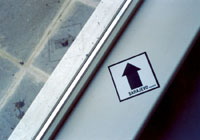
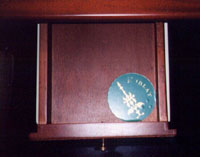
Kamericfs HomeSICK and ordinary Qibla
The work HomeSICK is the endless project of Kameric, and while she is away from
Sarajevo, she always exhibits this arrow at the different public and semi-public
spaces. This exhibition plan comes from the ordinary life of Muslim which uses
Qibla, the sign to show the direction of Mecca for praying. However, her qilba
points the direction of Sarajevo, her hometown. The encouragement of this work
comes from her experience that just by accident that while Kameric were creating
HomeSICK, she find the interesting description about the word "home-sick"
in Longman Dictionary of American English.
* home-sick, feeling sad because you are away from your home:
On her first
night at camp,
Sheila felt very homesick for her family.
- Longman Dictionary of American English
By this quotation, Sejla uses the difference of language and social structure between the United States and Bosnia to double reflect herself. The camp in American English is a camp as leisure, but the camp in Bosnia during the war can be a "concentration camp" or "refugee camp." In American English, Sheila is experiencing the transient ghomesickh, but the ghomesickh of Sejla in Bosnian mother tongue can be very serious.
Furthermore, this is not homesick, but homeSICK. She is worried about sick Sarajevo from far away. Also this photo of installation view reflects the part of qibla itself on the window, which tells that she does not forget to reflect herself in social relativity.
4. Imagine
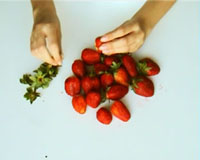
Imagine, 2004@Color video, PAL, 2 min
"Imagine,
they dig trough the garbage. Some people dig trough the garbage.
Imagine, trough my garbage. Can you imagine that?"
5. Original Work of Art in Residence for 1 Month "Sejla-san / ZC ² / Sejla Dream"
Also the curator Shinya
Watanabe asks Kameric to stay for one month in Japan and make some original
work for this Another Expo. Kameric stayed in Kyoto, and she made an art work
called "Sejla-san / ZC ² / Sejla Dream".
This work was exhibited both in Kitakyushu, Japan and in New York City.
Appendix: 1.EU/Others
This is the installation view of EU/Others at Manifesta III which is curated by Francesco Bonami, Ole Bouman, Maria Hlavajeva and Kathrine Rhomberg at Ljubljana, the capital of Slovenia in 2002. Slovenia is a country which became independent from Yugoslavia in 1991. Since then, Slovenian citizens have tried to be sophisticated European citizen, not Balkans. Year 2000 was the big year for Slovenian citizens, since this year, Slovenia was approved to be the member of the European Union.
At the central area of Ljubljana, there are two bridges. Kameric put the sign says gEUh on the main bridge and the sign gOthersh on the other bridge such as the passport control in the airport. The design of Euro currency is a design of bridge, which is a symbol of crossing the nations and fusion of the culture. However, the flow of capital from Western Europe to Slovenia in the 1980s accelerated the corruption of Yugoslavia, the former communist country. By using this sign, Kameric succeeded to show the transition of Slovenia from a communism country to a capitalistic European country.
2. Fortune Teller
When she ate Chinese food at the restaurants, she found the fortune teller says gYou will never be last in line, you will always excel! Lucky Numbers 9, 21, 30,31,32,33.h She expanded this message of fortune cookie, and exhibit it many places in former Yugoslavia.
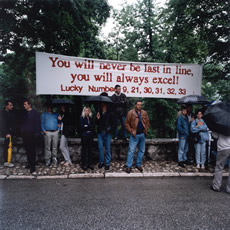
She expanded this message of fortune cookie, and exhibits it in two places.
One of those places is in front of the Austrian embassy in Sarajevo. During
the Bosnian War, lots of people became refugee and tried to enter other European
countries. However, lots of European countries were negative to accept the refugees.
In front of the building of Austria embassy, there is a line of people who are
waiting for getting refugee visa or even ordinary entry. However, the number
of the people who enter the building is limited, and lottery system was adopted.
So Kameric exhibit the message of Fortune Cookie in front of this embassy. Under
this message, there were people who are waiting for the result of lottery.
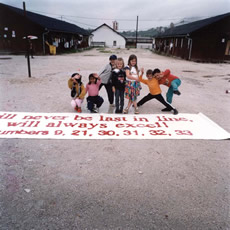
Also she exhibited this banner at asylum camp.
(C) Copyright Shinya Watanabe